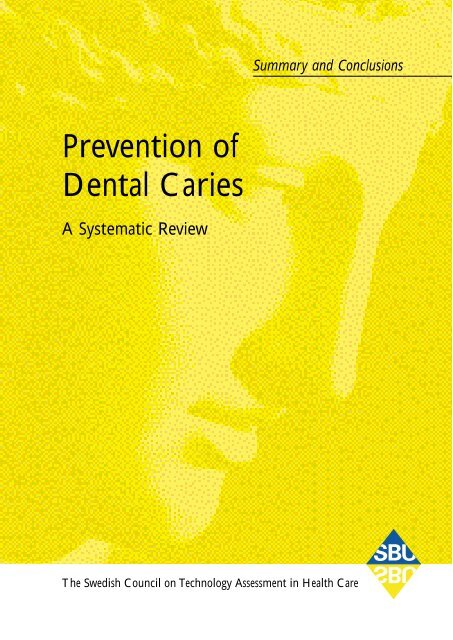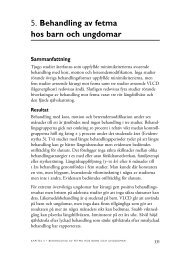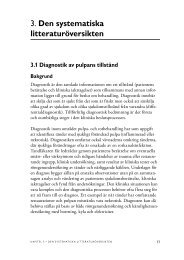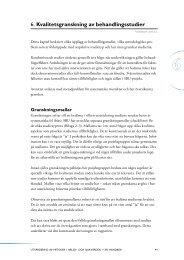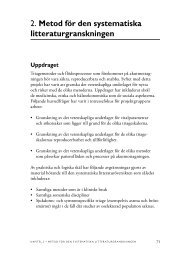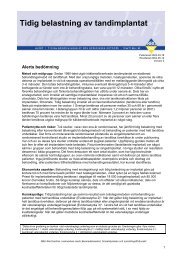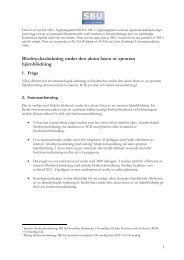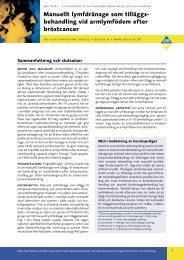Prevention of Dental Caries - SBU
Prevention of Dental Caries - SBU
Prevention of Dental Caries - SBU
Create successful ePaper yourself
Turn your PDF publications into a flip-book with our unique Google optimized e-Paper software.
Summary and Conclusions<br />
<strong>Prevention</strong> <strong>of</strong><br />
<strong>Dental</strong> <strong>Caries</strong><br />
A Systematic Review<br />
The Swedish Council on Technology Assessment in Health Care
<strong>SBU</strong> Board <strong>of</strong> Directors and<br />
Advisory Committee<br />
Secretariat<br />
EGON JONSSON,<br />
Executive Director<br />
<strong>SBU</strong> Board <strong>of</strong> Directors<br />
KJELL ASPLUND<br />
Norrland University<br />
Hospital (Chair)<br />
BIBBI CARLSSON<br />
The Swedish Federation <strong>of</strong><br />
County Councils<br />
EVA FERNVALL MARKSTEDT<br />
The Swedish Association <strong>of</strong><br />
Health Pr<strong>of</strong>essionals<br />
BERNHARD GREWIN<br />
Swedish Medical Association<br />
THOMAS IHRE<br />
The Swedish Society <strong>of</strong><br />
Medicine<br />
TORE LÖWSTEDT<br />
The Swedish Federation <strong>of</strong><br />
County Councils<br />
Advisory Committee<br />
PETER ASPELIN<br />
Huddinge University<br />
Hospital (Chair)<br />
HANS-OLOV ADAMI<br />
The Karolinska Institute<br />
CECILIA BJÖRKELUND<br />
Dept <strong>of</strong> Primary Health Care<br />
ANN-KATHRINE GRANÉRUS<br />
Linköping University<br />
Hospital<br />
NINA REHNQVIST-AHLBERG<br />
National Board <strong>of</strong> Health<br />
and Welfare<br />
MADELEINE ROHLIN<br />
Faculty <strong>of</strong> Dentistry, Malmö<br />
ULLA ÅHS<br />
The Swedish Association <strong>of</strong><br />
Local Authorities<br />
MARIE ÅSBERG<br />
The Karolinska Institute<br />
ANDERS LINDGREN<br />
Ministry <strong>of</strong> Health and<br />
Social Affairs<br />
DAG LUNDBERG<br />
Lund University Hospital<br />
BJÖRN BEERMANN<br />
Medical Products Agency<br />
DAVID BERGQVIST<br />
Uppsala University Hospital<br />
BIRGITTA BERNSPÅNG<br />
Umeå University<br />
KERSTIN HAGENFELDT<br />
Karolinska University<br />
Hospital<br />
ANNA-KARIN HOLM<br />
School <strong>of</strong> Dentistry, Umeå<br />
BENGT JÖNSSON<br />
Stockholm School <strong>of</strong><br />
Economics<br />
MÅNS ROSÉN<br />
National Board <strong>of</strong> Health<br />
and Welfare<br />
LIL TRÄSKMAN-BENDZ<br />
Lund University Hospital<br />
GIGGI UDÉN<br />
Malmö University
Summary and Conclusions <strong>of</strong> the <strong>SBU</strong> Report on:<br />
<strong>Prevention</strong> <strong>of</strong><br />
<strong>Dental</strong> <strong>Caries</strong><br />
A Systematic Review<br />
October 2002<br />
Report prepared by:<br />
Anna-Karin Holm<br />
(Chair)<br />
Susanna Axelsson<br />
(Project Coordinator)<br />
Helena Dahlgren<br />
Göran Hammarsjö<br />
Carina Källestål<br />
Folke Lagerlöf<br />
Peter Lingström<br />
Ingegerd Mejàre<br />
Gunilla Nordenram<br />
Anders Norlund<br />
Lars G Petersson<br />
Åsa Svensson<br />
(Project Assistant)<br />
Birgitta Söder<br />
Svante Twetman<br />
Manuscript reviewed by:<br />
Douglas Bratthall<br />
Ernst Jonsson<br />
Sven Poulsen<br />
Paul Riordan<br />
Eeva Widström<br />
English translation by:<br />
Ron Gustafson<br />
Report: <strong>Prevention</strong> <strong>of</strong> <strong>Dental</strong> <strong>Caries</strong> • Type: Systematic review<br />
ISBN: 991-87890-81-X • Report number: 161 • Publishing year 2002<br />
3
<strong>SBU</strong> Summary<br />
and Conclusions<br />
Introduction<br />
<strong>Dental</strong> caries, also referred to as “tooth decay”, is a disease that<br />
appears in all countries and all populations, but varies in scope<br />
and degree <strong>of</strong> severity.<br />
In Sweden, caries increased dramatically during the late 1800s<br />
and the early 1900s. Studies conducted in the early 1960s showed<br />
that approximately one fourth <strong>of</strong> those over the age <strong>of</strong> 16 years were<br />
completely toothless due to caries or periodontal disease, and<br />
nearly 100 percent <strong>of</strong> all children and adolescents had caries to a<br />
greater or lesser extent.<br />
How does caries start<br />
Bacteria attaches to the thin layer <strong>of</strong> bi<strong>of</strong>ilm found on all surfaces<br />
in the mouth, forming dental plaque on the teeth. Bacteria in the<br />
bi<strong>of</strong>ilm feed mainly on substances in the saliva, but many <strong>of</strong> them<br />
can use the sugar in our diet and convert it into acid, mainly lactic<br />
acid. This causes the pH value to fall, and protons, hydrogen ions,<br />
find their way in among the calcium phosphate crystals that form<br />
the tooth surface. Eventually, they partially dissolve and the released<br />
calcium and phosphate ions move out from the tooth, ie, demineralization.<br />
With a reduction in access to sugar, acid production<br />
declines, the pH value increases, and some recovery occurs. The<br />
tooth substance is rebuilt partly from the calcium and phosphate<br />
that remains in the fluid surrounding the tooth crystals, ie, remineralization.<br />
Initial demineralization is not visible to the naked eye.<br />
However, if acid is allowed to attack <strong>of</strong>ten and remineralization does<br />
not occur, then more mineral dissolves and an early caries lesion<br />
becomes visible as a white, chalk-like spot on the tooth surface.<br />
Initial caries lesions <strong>of</strong> tooth surfaces that are in contact with each<br />
FROM THE REPORT PREVENTION OF DENTAL CARIES<br />
5
other are also visible by x-ray examination. An initial lesion may<br />
heal, but <strong>of</strong>ten remains as a “scar”, an opaque and perhaps darkened<br />
area on the tooth surface. If the initial lesion does not heal and<br />
additional mineral is dissolved, the enamel surface disintegrates and<br />
a cavity forms. This occurs at a rather late stage <strong>of</strong> the caries process.<br />
The strength <strong>of</strong> the “attacking” factors, ie, the composition and<br />
amount <strong>of</strong> bacteria, and their access to sugar, determines the progression<br />
<strong>of</strong> the caries process. Saliva is the most important defense<br />
mechanism. It helps keep the tooth surface clean and dilutes sugar<br />
concentration. Saliva also has the ability to resist pH changes.<br />
Furthermore, it provides calcium and phosphate ions that contribute<br />
to remineralization <strong>of</strong> the tooth surface.<br />
Where does caries start<br />
Most commonly, caries is found on the occlusal surfaces <strong>of</strong> the<br />
teeth that have deep fissures. <strong>Caries</strong> also occurs on tooth surfaces<br />
that are in contact with each other. The border between a tooth<br />
and a filling or crown is another area prone to caries, ie, secondary<br />
caries. With age, there is a greater risk that the root surfaces become<br />
exposed as the gingiva recede. The root surface is more susceptible<br />
to acid damage than is tooth enamel, and therefore caries<br />
on root surfaces is common in older people.<br />
Who gets caries<br />
<strong>Caries</strong> may appear in all people if the balance between the “attack”<br />
and the “defense” factors is disturbed for a longer period. This<br />
can result from, eg, behavioral changes, since the balance is <strong>of</strong>ten<br />
maintained when we keep our teeth as free from bacteria as possible,<br />
avoid eating sugar too <strong>of</strong>ten, and use fluoride. These rather simple<br />
rules are not followed by everyone, and are least followed in socially<br />
disadvantaged environments. Other factors, eg, disease and/or<br />
medication, may also increase the risk for caries.<br />
The occurrence <strong>of</strong> caries may vary by individual even though<br />
behavioral-related factors appear to be similar. These differences<br />
may be due to variations in the amount and composition <strong>of</strong> saliva,<br />
6<br />
<strong>SBU</strong> SUMMARY AND CONCLUSIONS
the amount <strong>of</strong> plaque, the composition <strong>of</strong> bacteria, and the resistance<br />
<strong>of</strong> tooth enamel. There is still a lack <strong>of</strong> knowledge in these<br />
areas.<br />
Who has caries<br />
Currently, nearly half <strong>of</strong> all children and adolescents in Sweden<br />
have no visible signs <strong>of</strong> caries, ie, no fillings or “cavities” in their<br />
teeth. However, a large share <strong>of</strong> them may have initial lesions that<br />
can be observed on radiographs <strong>of</strong> tooth surfaces in contact with<br />
each other. <strong>Caries</strong> develops slowly in most children and adolescents,<br />
mainly as a result <strong>of</strong> fluoride use. In contrast to those<br />
children and adolescents who have little or no caries, there is also<br />
one group with moderate, and one group with major, sometimes<br />
early caries lesions. These children and adolescents are <strong>of</strong>ten classified<br />
as the high-risk group. The group includes many immigrants<br />
and refugees who may have extensive caries as they come from<br />
countries where dental care is not prioritized or they have lived<br />
under difficult conditions.<br />
<strong>Caries</strong> is less common today than it was 50 years ago, but it<br />
remains a health problem for many children and youth in<br />
Sweden. Adults may also have major care needs as a result <strong>of</strong> caries,<br />
particularly those who did not receive preventive care during their<br />
youth. Among the group aged 65–84 years in 1996/1997,<br />
approximately one fourth were completely toothless. Because an<br />
increasing number <strong>of</strong> people manage keep their teeth at higher ages,<br />
and because the average length <strong>of</strong> life is increasing, the need for<br />
both preventive and restorative dental care will increase among<br />
adults and the aging population in Sweden.<br />
Although Sweden has had public dental insurance since 1974,<br />
dental health is unequally distributed. Studies show that adults in<br />
families with low educational level, no cash margin, and immigrant<br />
backgrounds have larger problems with chewing and lower<br />
dental care utilization. The probability that the children (3–15<br />
years) in these families have, or have had, caries is also higher.<br />
FROM THE REPORT PREVENTION OF DENTAL CARIES<br />
7
Fluoride<br />
Over 50 years ago it was discovered that a natural level <strong>of</strong> approximately<br />
1 ppm (1 mg/l) fluoride in drinking water could reduce the<br />
occurrence <strong>of</strong> caries in large population groups. It was claimed that<br />
this was due to a systemic effect, ie, that incorporation <strong>of</strong> fluoride<br />
in the enamel lattice during tooth formation and mineralization,<br />
made tooth enamel more resistant to acid. Consequently, fluoride<br />
was added to drinking water in areas where the natural fluoride<br />
level was low. Fluoride was also added to foods such as salt and<br />
milk, and children who lived in areas where the fluoride content<br />
in drinking water was low received fluoride tablets.<br />
Research in the late 1970s showed that fluoride had primarily a<br />
local effect, ie, it worked by being present in the plaque fluid<br />
during the caries challenge, slowing down demineralization and<br />
promoting remineralization.<br />
<strong>Caries</strong> prevention<br />
The rate <strong>of</strong> caries in Sweden was very high in the late 1950s and<br />
early 1960s. Treatment consisted <strong>of</strong> replacing lost tooth substance<br />
with fillings, crowns, and bridges, and by extracting teeth that<br />
could not be repaired. However, it became increasingly obvious<br />
that this was not the way to cure caries.<br />
In the mid to late 1960s, a caries prevention intervention program<br />
was initiated, mainly among children and adolescents and within<br />
the framework <strong>of</strong> the public dental service. One <strong>of</strong> the first interventions<br />
was aimed at rinsing the mouth with a fluoride solution<br />
every week or every second week during preschool and primary<br />
school, initially under the supervision <strong>of</strong> school teachers.<br />
Child health centers began <strong>of</strong>fering special information sessions<br />
for parents on several occasions before the child reached age three<br />
years. <strong>Dental</strong> staff informed patients about toothbrushing, good<br />
diet, and the use <strong>of</strong> fluoride. From the early 1970s, children were<br />
called to the public dental service at age three or four years, and<br />
the primary teeth were also restored – something that had not<br />
been done earlier. <strong>Dental</strong> nurses received special training to<br />
8<br />
<strong>SBU</strong> SUMMARY AND CONCLUSIONS
educate and instruct children and parents about tooth care, to<br />
perform pr<strong>of</strong>essional tooth cleaning, and to give local fluoride treatment.<br />
Daily use <strong>of</strong> fluoride toothpaste was encouraged. The public<br />
dental service was heavily engaged in improving dental health,<br />
mainly in children and adolescents. During the 1970s, the rate <strong>of</strong><br />
caries declined markedly in children and adolescents. The improvement<br />
<strong>of</strong> dental health could be noted during most <strong>of</strong> the 1980s.<br />
Today, the decline in caries is no longer as obvious.<br />
Assignment<br />
On assignment from the Swedish Government in 1999, <strong>SBU</strong> initiated<br />
a project to scientifically assess the area <strong>of</strong> dentistry and oral<br />
health. Earlier reports by <strong>SBU</strong> addressed<br />
“Need to assess dental care” and<br />
“Smoking and oral health<br />
problems”.<br />
An early stage<br />
in planning the<br />
project involved<br />
asking approximately<br />
1 000<br />
dentists to<br />
submit proposals<br />
concerning<br />
areas they<br />
believed<br />
needed to be<br />
scientifically<br />
assessed. <strong>Caries</strong><br />
prevention was<br />
among the topics<br />
that most dentists<br />
viewed as a priority.<br />
9
A review group was established and began working in December<br />
<strong>of</strong> 1999.<br />
The methods used to prevent caries are the same as those used<br />
to treat early caries lesions. Although the methods appear to be<br />
simple, major disagreement exists concerning the effects reported<br />
in the scientific literature. Also, there are variations in dental<br />
health practices. The report systematically and critically reviews<br />
the scientific evidence for the effects that the different methods<br />
have on caries prevention.<br />
Project methodology<br />
Literature review<br />
The Project Group conducted a systematic review <strong>of</strong> the methods<br />
for caries prevention to determine the state <strong>of</strong> knowledge in the<br />
field. Using different search terms, the Medline database was searched<br />
for literature published between 1966 and 2001. The Group<br />
searched mainly for studies based on randomized controlled trials<br />
(RCT), but due to the low number <strong>of</strong> such studies, nonrandomized<br />
clinical controlled trials (CCT) were also included.<br />
Retrospective studies, studies with follow-up times less than<br />
two years for permanent teeth, and studies that did not use caries<br />
as an endpoint were excluded from further review. Less stringent<br />
requirements were placed on the length <strong>of</strong> follow-up time in studies<br />
<strong>of</strong> primary teeth, root surfaces, and caries in patients receiving<br />
radiotherapy. Using a structured protocol, approximately 900<br />
articles were reviewed in terms <strong>of</strong> the strength <strong>of</strong> the evidence and<br />
treatment results. The conclusions in this report are based on studies<br />
judged as having high-grade or moderate-grade evidence. In<br />
formulating the conclusions, findings concerning the effects <strong>of</strong><br />
the methods evaluated are rated according to the following scale:<br />
strong scientific evidence (Grade 1), moderate scientific evidence<br />
(Grade 2), limited scientific evidence (Grade 3), or insufficient<br />
scientific evidence (Grade 4). In the sections addressing “impaired<br />
saliva secretion and caries prevention” and “economic aspects”,<br />
10<br />
<strong>SBU</strong> SUMMARY AND CONCLUSIONS
few or no studies <strong>of</strong> high or moderate scientific evidence could be<br />
identified, and therefore the review also includes studies with<br />
shorter follow-up times and other study designs.<br />
The conclusions derived from this comprehensive and systematic<br />
review are presented in the report. The Project Group placed high<br />
standards on the scientific studies used as a basis for the conclusions.<br />
Accepting a lower standard <strong>of</strong> evidence would probably have permitted<br />
the Group to formulate more, but less reliable, conclusions.<br />
The report includes several conclusions based on Grade 4 evidence,<br />
ie, “insufficient scientific evidence”. “Insufficient” indicates<br />
that there are too few studies <strong>of</strong> high or moderate quality to enable<br />
the Project Group to draw reliable conclusions on the preventive<br />
effects against caries. It is important to emphasize that Grade 4<br />
does not necessarily indicate that a method has no clinical effects.<br />
However, if the scientific documentation shows that a method has<br />
no effects, its use should be questioned.<br />
Results<br />
Methods for caries prevention<br />
The methods reviewed included the use <strong>of</strong> fluoride in different<br />
forms and dosages, interventions targeted at diet (eg, using sugar<br />
replacement products), methods <strong>of</strong> removing plaque, fissure sealants<br />
and methods to prevent caries when saliva secretion is<br />
impaired. The economic and ethical aspects are presented in separate<br />
chapters.<br />
Fluoride<br />
The most commonly used product containing fluoride is fluoride<br />
toothpaste, which dominates the toothpaste market. The amount<br />
<strong>of</strong> fluoride in toothpaste varies between 250 ppm and 2 500 ppm.<br />
In Sweden, the maximum allowed concentration is currently<br />
1 500 ppm. Strong scientific evidence shows that the use <strong>of</strong> fluoride<br />
toothpaste has an effect on the prevention <strong>of</strong> caries in the permanent<br />
FROM THE REPORT PREVENTION OF DENTAL CARIES<br />
11
12<br />
teeth <strong>of</strong> children and young adults (Grade 1). This effect is dose<br />
dependent, ie, toothpaste with higher fluoride concentration,<br />
1 500 ppm fluoride, yields better effect than toothpaste with<br />
1 000 ppm (Grade 1). The effect <strong>of</strong> fluoride toothpaste on primary<br />
teeth has been insufficiently assessed, as have the effects in adults<br />
and elderly people. However, nothing suggests that preventive<br />
effects would not be found in these age groups. In addition to fluoride<br />
toothpaste, other products include fluoride solutions for<br />
mouthrinsing and fluoride tablets intended to enhance the effects<br />
<strong>of</strong> fluoride toothpaste in patients with high caries activity or at<br />
high risk for caries. The literature <strong>of</strong>fers limited evidence that<br />
fluoride mouthrinsing daily, weekly, or once every two weeks has<br />
an effect in children and adolescents beyond that achieved by<br />
daily use <strong>of</strong> fluoride toothpaste (Grade 3). Only a few<br />
studies have been performed on adults.<br />
Three <strong>of</strong> these studies have suggested<br />
that daily mouthrinsing with fluoride<br />
solution prevents root caries in older<br />
people (Grade 3). The preventive<br />
effect <strong>of</strong> using fluoride tablets<br />
as adjunct treatment against<br />
caries has been insufficiently<br />
assessed (Grade 4).
Varnishes and gels containing fluoride are available for pr<strong>of</strong>essional<br />
use. Gels are also available for self-care at home. Fluoride varnish<br />
can be applied on to the teeth. After drying and hardening, the<br />
varnish slowly releases fluoride ions. A preventive effect on caries<br />
has been shown when treatment is repeated at least twice per year<br />
in children and adolescents also with concurrent use <strong>of</strong> fluoride<br />
toothpaste (Grade 3). However, the evidence is insufficient for<br />
assessing the preventive caries effects on the primary teeth. The<br />
assessments that have been performed on patients with high caries<br />
activity do not provide sufficient evidence for drawing reliable<br />
conclusions. There are no studies on adults and elderly people.<br />
Regarding fluoride gels, too few studies have been done to reliably<br />
assess the preventive effects on caries. In part, this is because<br />
treatment with fluoride gel is expensive and mainly occurs in the<br />
United States. In Sweden, fluoride gel has been used primarily to<br />
treat severely ill patients with high caries activity.<br />
To deliver small doses <strong>of</strong> fluoride to the saliva several times per<br />
day, fluoride can be added to drinking water, table salt, or milk.<br />
Fluoride in drinking water is shown to have a preventive effect on<br />
caries, but the Swedish National Food Administration regulations<br />
do not permit fluoride to be added to drinking water in Sweden.<br />
Fluoride in table salt is available in several countries, while fluoride<br />
in milk has not been widely used anywhere. The scientific evidence<br />
for assessing the effect <strong>of</strong> fluoride salt or fluoride milk is insufficient<br />
to draw conclusions (Grade 4).<br />
Diet and diet-related factors<br />
Sugar is an important substrate for caries-promoting bacteria.<br />
Currently, and for the past ten years in Sweden, sugar consumption<br />
has exceeded 40 kilos per person and year. Reducing sugar<br />
consumption and the frequency <strong>of</strong> intake would help improve<br />
both dental health and health generally. The effects <strong>of</strong> the dietary<br />
information provided by dental staff, mainly to children, adolescents,<br />
and parents visiting child health centers and at the regular<br />
dental visits, has never been assessed in scientific studies.<br />
FROM THE REPORT PREVENTION OF DENTAL CARIES<br />
13
Internationally, studies assessing the effects <strong>of</strong> dietary information<br />
are also lacking.<br />
Various sugar substitutes are available on the market. Perhaps<br />
the most well known and commonly used are sorbitol and xylitol,<br />
sugar alcohols that are mainly used in products such as chewing<br />
gum and lozenges. Despite several studies, the evidence is insufficient<br />
to determine if they have a preventive effect on caries (Grade 4).<br />
Mechanical and chemical plaque removal,<br />
prevention programs<br />
Toothbrushing one or two times per day is an established habit<br />
among most people. The scientific literature <strong>of</strong>fers no evidence that<br />
toothbrushing alone, without the simultaneous use <strong>of</strong> fluoride, has a<br />
preventive effect against caries. Varying results have been reported in<br />
studies <strong>of</strong> pr<strong>of</strong>essional tooth cleaning without fluoride. However,<br />
when fluoride is administered concurrently, a preventive effect on<br />
caries has been shown in children and adolescents (Grade 3).<br />
Chlorhexidine and triclosan are antimicrobial agents that can be<br />
added to toothpaste, varnishes, and gels for the purpose <strong>of</strong> preventing<br />
caries. Chlorhexidine is also used in solutions for mouthrinsing.<br />
Results have been contradictory in the studies involving chlorhexidine<br />
gel. There is no scientific evidence upon which to judge the preventive<br />
effects <strong>of</strong> triclosan on caries (Grade 4). Xylitol, a sugar substitute,<br />
can be found as an additive in fluoride toothpaste. However, there is<br />
no scientific evidence to show that xylitol yields an effect beyond that<br />
<strong>of</strong> the fluoride which has already been added (Grade 3).<br />
Studies that describe different programs <strong>of</strong> caries prevention were<br />
also reviewed. These programs <strong>of</strong>ten include a combination <strong>of</strong> information<br />
about caries disease, instruction in toothbrushing, and regular<br />
pr<strong>of</strong>essional tooth cleaning. Fluoride may also be administered<br />
via polishing pastes, gels, mouthrinsing, and fluoride tablets. Most<br />
programs that include fluoride in some form show a reduction in<br />
caries between 30 percent and 70 percent (Grade 2). It could not be<br />
shown that any particular combination <strong>of</strong> interventions or fluoride<br />
agents were more effective than any others.<br />
14<br />
<strong>SBU</strong> SUMMARY AND CONCLUSIONS
Fissure sealants<br />
Fissure sealants are used on occlusal surfaces <strong>of</strong> the teeth. Occlusal<br />
surfaces have fissures that make tooth cleaning difficult and<br />
allow caries to start. The method involves applying a thin, very<br />
fluid, plastic material directly to the fissures. To retain the material<br />
to the tooth, its surface is pretreated with an acid that creates<br />
small pores in the enamel. The material fills the pores and thereby<br />
mechanically bonds to the tooth surface, creating a smooth<br />
and even surface. It is essential to keep the tooth absolutely dry<br />
during treatment. If not, the pores can fill with saliva and the<br />
sealant attaches poorly. Sealants must be applied soon after the<br />
tooth emerges to prevent early caries.<br />
Intact sealants have the potential to prevent caries on the<br />
occlusal surface. The method is not invasive and causes no pain.<br />
However, sealants are technically sensitive, and require continual<br />
checking and repair, or replacement if needed. Many studies have<br />
been reviewed to determine the preventive effects <strong>of</strong> fissure sealants<br />
composed <strong>of</strong> resin-based material. Many <strong>of</strong> the studies are outdated<br />
and deficient in study design and follow-up. Hence, there is<br />
only limited evidence in the literature that fissure sealants prevent<br />
caries in the short and long term (Grade 3). The literature <strong>of</strong>fers<br />
insufficient evidence to assess other types <strong>of</strong> material used as fissure<br />
sealants (Grade 4). The scientific documentation also <strong>of</strong>fers<br />
insufficient evidence for determining if fissure sealants have a preventive<br />
effect against caries in populations with low and high rates<br />
<strong>of</strong> caries (Grade 4).<br />
Impaired saliva secretion and caries prevention<br />
Originally, the objective <strong>of</strong> this chapter was to review methods for<br />
preventing caries in people with various functional impairments,<br />
chronic diseases, dementia, etc. The initial search revealed very few<br />
clinical controlled studies <strong>of</strong> caries prevention methods in these<br />
patient groups. Several studies, however, could be identified under<br />
the heading <strong>of</strong> “impaired saliva secretion”. Since patients who were<br />
included in these studies <strong>of</strong>ten had lower saliva secretion due to<br />
FROM THE REPORT PREVENTION OF DENTAL CARIES<br />
15
adiation therapy, and were severely ill, the inclusion<br />
requirements for, eg, follow-up time and for the control<br />
groups could not be fulfilled. Consequently, the weight<br />
<strong>of</strong> the evidence in these studies was not assessed, and<br />
they were only reviewed and summarized.<br />
The studies that were assessed showed a preventive<br />
effect against caries from treatment using trays with fluoride<br />
gel in patients who had been exposed to radiation<br />
treatment in the head and neck. The effects<br />
were dependent on the level <strong>of</strong> saliva secretion,<br />
ie, the less it had been affected the<br />
greater the effects <strong>of</strong> treatment.<br />
Economic aspects<br />
In Sweden, the total cost to society for dental<br />
care in 1998 was approximately 12 billion<br />
Swedish kronor (SEK). That year, the cost for<br />
caries prevention in adults was approximately 1.1<br />
billion SEK, and the cost for caries prevention in<br />
children was approximately 0.2 billion SEK.<br />
Only a few original studies that investigated<br />
the effects <strong>of</strong> caries prevention have included an<br />
economic analysis. These studies <strong>of</strong>fer insufficient<br />
evidence supporting the economic benefits <strong>of</strong> the<br />
forms <strong>of</strong> caries prevention reviewed. Furthermore,<br />
the evidence in the studies reviewed is inconsistent.<br />
There are no economic studies on cost effectiveness<br />
concerning the use <strong>of</strong> fluoride toothpaste<br />
in children and adolescents. Nevertheless, it can be<br />
asserted that the most cost-effective form <strong>of</strong> caries<br />
prevention is daily use <strong>of</strong> fluoride toothpaste since<br />
the cost for adding fluoride to toothpaste is extremely<br />
low.<br />
16<br />
<strong>SBU</strong> SUMMARY AND CONCLUSIONS
Ethical aspects<br />
Patient autonomy is a central and important ethical value in<br />
health care. People should not be exposed to treatment or preventive<br />
interventions against their will. Regarding decisions on caries<br />
prevention that affect individuals with low or limited autonomy,<br />
eg, those with psychological function disorders or dementia, it is<br />
<strong>of</strong> utmost importance to respect their integrity. Differences in<br />
dental health can, as mentioned earlier, result from differences<br />
in ethnic background or socioeconomic conditions. From an<br />
ethical perspective, this can be viewed as a breach <strong>of</strong> justice<br />
and does not meet the requirements for good dental health<br />
on equal terms as stipulated by the <strong>Dental</strong> Services Act.<br />
From an ethical standpoint, studies that have assessed<br />
the preventive effects <strong>of</strong> xylitol or sorbitol can be questioned.<br />
Trial subjects, <strong>of</strong>ten children, have been given sweet chewing<br />
gum or other similar product 3–5 times per day for<br />
2–3 years and thereby may have become accustomed to daily<br />
consumption <strong>of</strong> sweets.<br />
Future research<br />
Our review found documented effects for several interventions<br />
to prevent caries, but also a major need for further studies <strong>of</strong><br />
good quality. The Project Group also identified a need for<br />
national epidemiological studies that could serve as a basis<br />
for research into caries prevention.<br />
Major deficiencies remain in our knowledge about the<br />
effects <strong>of</strong> local fluoride treatment. The question concerns<br />
not only whether fluoride treatment can prevent new<br />
caries, but also the effect that treatment has on existing<br />
lesions caused by caries. Since the current trend is to delay<br />
operative intervention <strong>of</strong> caries lesions, it is increasingly<br />
important to study the effects <strong>of</strong> different interventions<br />
on the caries process. Above all, current evidence is insufficient<br />
to determine the effects <strong>of</strong> treatment on adults<br />
and the elderly. Furthermore, surprisingly few studies<br />
FROM THE REPORT PREVENTION OF DENTAL CARIES<br />
17
have been conducted on patients with high caries activity and on<br />
those who are at high risk for caries. It is essential to conduct randomized<br />
trials on the effects <strong>of</strong> fissure sealants in preventing caries.<br />
Such trials should be performed under normal clinical conditions<br />
within the framework <strong>of</strong> dental health services for children and<br />
adolescents. Studies in young adults on teeth sealed earlier,<br />
would provide knowledge on whether sealants have any preventive<br />
effects on caries in the long term. Studies are lacking in<br />
populations with high caries activity.<br />
An increasing number <strong>of</strong> people keep their own teeth until they<br />
reach higher ages. Since the average life expectancy is increasing<br />
in Sweden, the adult and aging population will have an increasing<br />
need for both preventive and reparative dental care. Older patients<br />
may need special attention in programs to prevent caries. Diseases<br />
and medications that lead to mouth dryness are common and<br />
increase the risk for caries, mainly in exposed root surfaces and at<br />
the borders <strong>of</strong> previous fillings. Many elderly people find it difficult<br />
to adequately manage their own oral hygiene. Preventive<br />
interventions for patients with chronic diseases and various<br />
functional impairments need programs that are designed and<br />
evaluated according to the special problems associated with the<br />
disease. Current evidence is insufficient to draw any conclusions<br />
concerning how prevention <strong>of</strong> caries should be designed for this<br />
group. This is an important area for future research. It is essential<br />
to include economic analyses in studies that assess preventive<br />
interventions against caries. This review did not identify any<br />
such study as having moderate- or high-grade evidence. In the<br />
absence <strong>of</strong> such studies, the health economics <strong>of</strong> efforts to prevent<br />
caries cannot be assessed.<br />
18<br />
<strong>SBU</strong> SUMMARY AND CONCLUSIONS
Conclusions<br />
❑<br />
❑<br />
❑<br />
❑<br />
❑<br />
<strong>Caries</strong> remains a major public health problem. Extensive<br />
damage from caries can lead to major problems for the individual,<br />
affecting quality <strong>of</strong> life both functionally and esthetically.<br />
Good general health also includes good oral health. Hence,<br />
preventing caries is an important element in public health efforts.<br />
Daily use <strong>of</strong> toothpaste with fluoride is an effective method <strong>of</strong><br />
preventing caries in permanent teeth <strong>of</strong> children and adolescents<br />
(Grade 1). The effects are dose-related, ie, toothpaste with a<br />
higher concentration <strong>of</strong> fluoride, 1 500 ppm, yields a better<br />
effect than toothpaste with 1 000 ppm (Grade 1). The scientific<br />
literature does not evaluate the preventive effects <strong>of</strong> fluoride<br />
toothpaste on primary teeth or in adult and elderly individuals<br />
(Grade 4). However, nothing would suggest that preventive<br />
effects would not be found in these age groups as well.<br />
Fluoride mouthrinsing daily, every week or every 14 days,<br />
can reduce the incidence <strong>of</strong> caries in children and adolescents,<br />
but adds no further protection to the daily use <strong>of</strong> fluoride<br />
toothpaste (Grade 3).<br />
Daily fluoride mouthrinsing is shown to have a preventive<br />
effect on root caries in elderly people (Grade 3).<br />
Pr<strong>of</strong>essional treatment using fluoride varnish at least twice<br />
annually has preventive effects on caries in young permanent<br />
teeth, even with concurrent use <strong>of</strong> fluoride toothpaste (Grade 3).<br />
There is no scientific evidence to assess the effects on primary<br />
teeth or in adults (Grade 4).<br />
20<br />
<strong>SBU</strong> SUMMARY AND CONCLUSIONS
❑<br />
❑<br />
❑<br />
❑<br />
The preventive effects <strong>of</strong> fluoride tablets on primary teeth or<br />
permanent teeth cannot be scientifically assessed, nor can the<br />
preventive effects <strong>of</strong> adding fluoride to milk or salt (Grade 4).<br />
The effect <strong>of</strong> information given to reduce sugar in the diet<br />
and aimed at preventing caries is insufficiently assessed. The<br />
scientific documentation is insufficient for determining whether<br />
sugar substitutes (sorbitol and xylitol) in chewing gum and<br />
sweets have any preventive effects on caries (Grade 4).<br />
<strong>Prevention</strong> programs involving fluoride have a preventive<br />
effect on caries in children and adolescents (Grade 2). There<br />
are no studies on adults, but there is no reason to assume that<br />
this principle would not apply to all age groups. Antibacterial<br />
additives to toothpaste, such as chlorhexidine and triclosan, have<br />
no confirmed preventive effects on caries. Likewise, adding<br />
xylitol to fluoride toothpaste does not yield additional effects<br />
beyond the effect <strong>of</strong> fluoride (Grade 3).<br />
The use <strong>of</strong> fissure sealants performed with resin-based material<br />
has a preventive effect on caries (Grade 3).<br />
conclusions<br />
❑<br />
❑<br />
Scientific documentation is insufficient to draw any conclusions<br />
concerning how the work to prevent caries should be organized<br />
for groups with special needs, eg, elderly patients, patients<br />
with chronic disease and patients at high risk for caries or<br />
with high caries activity (Grade 4).<br />
There are no studies with sufficiently high-grade evidence to<br />
assess the economic effects <strong>of</strong> interventions to prevent caries.<br />
FROM THE REPORT PREVENTION OF DENTAL CARIES<br />
21
Effects <strong>of</strong> interventions to prevent caries – overview<br />
Intervention Effect Grade Comments Chapter<br />
Fluoride toothpaste + 1 Permanent teeth, 3.1<br />
children and adolescents,<br />
daily use<br />
Fluoride rinsing + 3 No additional effect 3.2<br />
during concurrent use<br />
<strong>of</strong> fluoride toothpaste<br />
and low caries rate<br />
Fluoride rinsing + 3 Individuals over 3.2<br />
for root caries<br />
60 years <strong>of</strong> age<br />
Fluoride topical application + 3 Permanent teeth 3.2<br />
Twice per year<br />
Fluoride varnish + 3 Permanent teeth 3.3<br />
Children and adolescents,<br />
at least twice per year<br />
Fluoride gel + 3 Acidified APF gel 3.4<br />
Fluoride tablets 4 Lozenges 3.5<br />
Fluoride in drinking water + 3 Not used in Sweden 3.6<br />
Assessed by NHS<br />
Fluoride in milk 4 Not used in Sweden 3.6<br />
Fluoride in salt 4 Not used in Sweden 3.6<br />
Dietary information 4 No studies 4<br />
Sorbitol in sweets 4 Insufficient documentation 4<br />
and chewing gum<br />
Xylitol in sweets 4 Insufficient documentation 4<br />
and chewing gum<br />
22<br />
<strong>SBU</strong> SUMMARY AND CONCLUSIONS
Intervention Effect Grade Comments Chapter<br />
<strong>Dental</strong> floss use 4 Contradictory results 5<br />
<strong>Prevention</strong> program 4 Insufficient documentation 5<br />
for caries active<br />
<strong>Prevention</strong> program + 2 No difference between 5<br />
using fluoride<br />
different combinations<br />
<strong>of</strong> interventions<br />
Tooth cleaning, 4 Without fluoride 5<br />
pr<strong>of</strong>essional<br />
Tooth cleaning, + 3 With concurrent use 5<br />
pr<strong>of</strong>essional<br />
<strong>of</strong> fluoride<br />
Triclosan in 4 No studies 5<br />
toothpaste<br />
Xylitol in toothpaste 0 3 Concurrent fluoride 5<br />
additives<br />
Fissure sealants + 3 Resin-based material 6<br />
conclusions<br />
Fissure sealants 4 Glass ionomer cements 6<br />
+ = favorable effect<br />
0 = no demonstrated favorable effect<br />
= uncertain effect<br />
The evidence for each method was graded as follows:<br />
1 = strong scientific support<br />
2 = moderate scientific support<br />
3 = limited scientific support<br />
4 = insufficient scientific support<br />
NHS = National Health Services, Great Britain<br />
FROM THE REPORT PREVENTION OF DENTAL CARIES<br />
23
Reports published by <strong>SBU</strong><br />
Swedish Yellow Reports<br />
<strong>Prevention</strong> <strong>of</strong> <strong>Dental</strong> <strong>Caries</strong> (2002), no 161<br />
<strong>Prevention</strong>, Diagnosis, and Treatment <strong>of</strong> Venous Thromboembolism (2002),<br />
three volumes, no 158/1+2+3<br />
Obesity – Problems and Interventions (2002), no 160<br />
Hormone Replacement Therapy (2002), no 159<br />
Treatment <strong>of</strong> Alcohol and Drug Abuse – An Evidence-Based Review (2001),<br />
two volumes, no 156/1+2<br />
Chemotherapy for Cancer (2001), two volumes, no 155/1+2<br />
Mild Head Injury (2000), no 153<br />
Treating Asthma and COPD (2000), no 151<br />
Stomach Pain – Evidence-Based Methods in theDiagnosis and Treatment <strong>of</strong><br />
Dyspepsia (2000), no 150<br />
Advanced Home Health Care and Home Rehabilitation – Reviewing the Scientific<br />
Evidence on Costs and Effects (1999), no 146<br />
Back and Neck Pain (2000), two volumes, no 145/1+2<br />
Evidence Based Treatment <strong>of</strong> Urinary Incontinence (2000), no 143<br />
Prognostic Methods in Acute Coronary Artery Disease (1999), no 142<br />
Routine ultrasound examination during pregnancy (1998), no 139<br />
Smoking cessation methods (1998), no 138<br />
Surgical treatment <strong>of</strong> rheumatic diseases (1998), two volumes, no 136/1+2<br />
Preventing disease with antioxidants (1997), three volumes, no 135/1+2+2:2<br />
Community intervention programs to prevent cardiovascular disease –<br />
A systematic review <strong>of</strong> the literature (1997), no 134<br />
Treatment with neuroleptics (1997) two volumes, no 133/1+2<br />
Hormone replacement therapy (1996), no 131<br />
Radiotherapy for cancer (1996), no 129/1<br />
Critical Issues in Radiotherapy (1996), no 129/2<br />
Bone density measurement (1995), no 127<br />
Mass screening for prostate cancer (1996), no 126<br />
The treatment and rehabilitation <strong>of</strong> traffic accident victims (1994), no 122<br />
Moderately elevated blood pressure (1994), no 121<br />
Genetic diagnosis by PCR (1993), no 118<br />
Diabetic retinopathy - the value <strong>of</strong> early detection (1993), no 117<br />
Stroke (1992), no 116<br />
24<br />
<strong>SBU</strong> SUMMARY AND CONCLUSIONS
MRI – magnetic resonance imaging (1992), no 114<br />
Surgery for epilepsy (1991), no 110<br />
Bone marrow transplantation (1989), no 109<br />
Back pain – causes, diagnosis, treatment (1991), no 108<br />
The problem <strong>of</strong> back pain – proceedings from a Conference (1989), no 107<br />
Lithotripsy for Kidney Stones and Gallstones, no 106<br />
Vascular Surgery for Arteriosclerosis in the Legs, no 105<br />
Gastroscopy in the diagnosis <strong>of</strong> dyspepsia (1990), no 104<br />
Preoperative routines (1989), no 101<br />
Swedish White Reports<br />
Smoking and Oral Health Problems (2002), no 157<br />
Need to Assess <strong>Dental</strong> Care (2000), no 152<br />
Sweden and Swedish Health Services – Economic Outlook III,<br />
Conference Report (2000), no 149<br />
Alert – New Methods in Health Care – Early assessment <strong>of</strong> costs and<br />
benefits (2000), no 148<br />
Children Born From In Vitro Fertilization (IVF) (2000), no 147<br />
Placebo (2000), no 154<br />
The Patient-Doctor Relationship and the Art <strong>of</strong> Medicine:<br />
An Evidence-Based Review (2000), no 144<br />
Evidence-Based Physiotherapy for Patients with Neck Pain (1999), no 102<br />
Evidence-Based Physiotherapy for Patients with Low-Back Pain (1999), no 101<br />
Evidence-Based Nursing – Treatment <strong>of</strong> people with schizophrenia (2000), no 4<br />
Evidence-Based Nursing in Treatment <strong>of</strong> People with Depression (1999), no 3<br />
Evidence Based Nursing: Patients With Moderate Hypertension (1998), no 2<br />
Evidence-Based NursingReport 1 Radiotherapy for patients with cancer (1998), no 1<br />
Chest Pain: Surgery, Balloon Dilation, Drugs (1998), no 140<br />
Sweden and Swedish Health Services – Economic Outlook II,<br />
Conference Report (1998), no 137<br />
Longer life and better health – A report on prevention (1997), no 132<br />
Sweden and Swedish Health Services – Economic Outlook I,<br />
Conference Report (1995), no 128<br />
Healthcare Trends in Sweden, 1960–1992 (1995), no 124<br />
Need for Assessment in Nursing (1994), no 123<br />
Need for Assessment in Psychiatry (1992), no 112<br />
FROM THE REPORT PREVENTION OF DENTAL CARIES<br />
25
Alert Reports<br />
Early assessments <strong>of</strong> new methods in health care.<br />
Find them at www.sbu.se in pdf-format under Alert.<br />
English Reports<br />
Evidence Based Nursing: Caring for Persons with Schizophrenia (1999/2001), no 4e<br />
Chemotherapy for Cancer (2001), no 155/2<br />
CABG/PTCA or Medical Therapy in Anginal Pain (1998) no 141e<br />
Bone Density Measurement, Journal <strong>of</strong> Internal Medicine,<br />
Volume 241 Suppl 739 (1997), 127/suppl<br />
Mass Screening for Prostate Cancer, International Journal <strong>of</strong> Cancer,<br />
Suppl 9 (1996), 126/suppl<br />
Radiotherapy for Cancer, Volume 1, Acta Oncologica, Suppl 6 (1996), 129/1/suppl<br />
Radiotherapy for Cancer, Volume 2, Acta Oncologica, Suppl 7 (1996), 129/2/suppl<br />
Critical Issues in Radiotherapy (1996), no 130e<br />
Hysterectomy – Ratings <strong>of</strong> Appropriateness... (1995), no 125e<br />
Moderately Elevated Blood Pressure, Journal <strong>of</strong> Internal Medicine, Volume 238<br />
Suppl 737 (1995), 121/suppl<br />
CABG and PTCA. A Literature Review and Ratings... (1994), no 120e<br />
Literature Searching and Evidence Interpretation (1993), no 119e<br />
Stroke (1992), no 116e<br />
The Role <strong>of</strong> PTCA (1992), no 115e<br />
Prioritizing and rationing in health care - actual trends in the USA.<br />
Report from a conference. (1991), no 111e<br />
The Problem <strong>of</strong> Back Pain – Conference Report (1989), no 107e<br />
Preoperative Routines (1989), no 101e<br />
To order <strong>SBU</strong> Reports<br />
The reports listed above can be ordered via the Internet at www.sbu.se,<br />
by phone (+46 8 412 32 00), or by fax (+46 8 411 32 60).<br />
26<br />
<strong>SBU</strong> SUMMARY AND CONCLUSIONS
<strong>SBU</strong> Evaluates<br />
Health Care Technology<br />
The Swedish Government has given <strong>SBU</strong> the following<br />
responsibilities:<br />
• <strong>SBU</strong> shall evaluate the methods used in health care by<br />
systematically and critically reviewing the scientific evidence<br />
in the field.<br />
• <strong>SBU</strong>’s assessments shall cover the medical aspects and the<br />
ethical, social, and economic consequences <strong>of</strong> disseminating<br />
and applying medical and dental technologies.<br />
• <strong>SBU</strong>’s assessments shall be compiled, presented, and<br />
disseminated in such a way that all affected parties have<br />
access to the information.<br />
• <strong>SBU</strong> shall contribute, through informational and educational<br />
initiatives, toward ensuring that the knowledge gained is used<br />
to rationally utilize available resources in health care.<br />
• <strong>SBU</strong> shall draw on national and international experience and<br />
research findings in the field and shall serve as a focal point<br />
for health technology assessment in Sweden. This effort shall<br />
be managed in a way that secures success and respect for the<br />
organization, both domestically and internationally.
<strong>Prevention</strong> <strong>of</strong> <strong>Dental</strong> <strong>Caries</strong><br />
<strong>SBU</strong>’s task is to critically review the scientific<br />
basis <strong>of</strong> methods used in health care and to<br />
evaluate their costs, risks, and benefits.<br />
This is a summary <strong>of</strong> the <strong>SBU</strong> report<br />
“<strong>Prevention</strong> <strong>of</strong> <strong>Dental</strong> <strong>Caries</strong>”.<br />
<strong>SBU</strong>, Box 5650, SE-114 86 Stockholm, Sweden • Visiting address: Tyrgatan 7<br />
Telephone: +46-8-412 32 00 • Fax: +46-8-411 32 60 • www.sbu.se • E-mail: info@sbu.se


